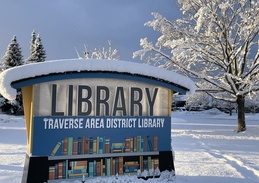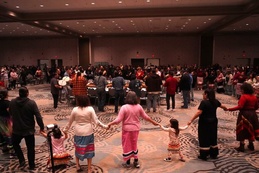Mind made up on Biomass?
March 28, 2010
Mind made up on biomass?By Anne Stanton
Traverse City Light and Power promised residents that it would fully
consider all alternatives before deciding on how to replace 30% of
its coal-powered energy with renewable energy by 2010.
But environmentalists say it looks like the utility has already made
up its mind to build a $30 million biomass plant based on a letter it
just sent out to customers. The head of the utility countered that no
decision’s been made, but added that biomass stands as the most
affordable option.
“That’s where all the arrows are pointed at this point,” said Ed
Rice, TCL&P’s executive director, adding that he tried to write the
letter sensitively so as not to give the impression that biomass was a
done deal.
“It appears from a financial aspect, the biomass would be most
advantageous. We should do the best we can for the ratepayers, many
of who are on a fixed income. When you make these decisions today,
it will have an impact 5 to 15 years from now and you try to forecast
the best you can.”
The one-page letter reads in part: “TCL&P is convinced that
alternative plans [that would exclude biomass] would cause
significantly higher electric rates which could cause severe financial
hardships to Traverse City citizens and businesses. This, in turn,
would erode the financial well being of our community.”
The letter comes at a time when the utility is meeting with
environmental leaders and citizens on how to gradually wean the
utility off from coal-powered energy. In two public meetings, it
proposed to break down its energy portfolio this way: coal, 55%,
biomass, 20%, wind 6%, landfill gas, 4%, and undetermined, 15%.
TCL&P will hold a public meeting on April 7 at the Hagerty Center,
where it will present the various energy scenarios. The board’s
biomass vote was postponed to April 20, Rice said.
Meanwhile, the Michigan Land Use Institute (MLUI) plans to present a
detailed plan this week that supports a heavier emphasis on wind than
TCL&P is suggesting -- 15% versus 6%. It also recommends getting 1%
from solar energy. There was a clear consensus from the community to
do more with wind and solar, said Hans Voss, MLUI’s executive
director.
“Traverse City Light and Power said they would do two things. One was
to listen to the public—and the public is bucking biomass—and number,
two, to show different scenarios at a meeting in early April based on
the input of the two public sessions. I think the letter they just
sent out is in conflict with that commitment and it was a real
disappointment,”
The Institute believes that a small biomass plant--perhaps 10
megawatts--can be part of the solution if done sustainably, but TCL&P
needs to first unify the public on biomass and show a stronger
commitment toward conservation. MLUI believes TCL&P should set a goal
of reducing energy demand by 2 percent a year and publicly track
progress. The Institute also supports what’s called a feed-in tariff,
a policy that sounds like a consumer tax, but isn’t. Essentially, it’s
a European born concept that pays profitable rates to people and
utilities that are generating renewable energy. “Think net metering on
steroids,” Voss said.
Greg Reisig, executive director of the Northern Michigan Environmental
Action Council, also questions the meaning behind TCL&P’s letter.
“They keep saying they haven’t made a decision, but it seems like
they’ve made a big decision.”
Reisig and others have criticized the utility for a process that
effectively involved the community late in the game. Now both sides
are bitterly sniping at each other, and the public is left feeling
confused over what to do next, said Bob Russell, co-director of the
Neahtawanta Center, a nonprofit peace and environmental group.
“I’d like them to really stop, go back and engage in a thoughtful
process with citizens of how are we going to use renewable energy.
Even to help set the goal. It’s nice that Traverse City Light and
Power picked 30% renewable as its goal. But if they’d gone to the
public and said, ‘We want to have 30%, the state says we are required
to do 10%, and what do you think is reasonable?’—then the citizens
could have been involved. But as it stands, 30% is not their number.
They were given that number from Light and Power.”
Russell believes that TCL&P should sit down with the public, list
their concerns, and see if there is a way of satisfying them.
TOO LATE?
The Traverse City Light and Power’s proposed program, tagged “30 by
10,” was presented in two public meetings a few weeks ago, with the
utility proposing that the utility shift to 30% renewable energy
sources by 2010. The utility pointed out that biomass is the cheapest
of all alternatives and would provide a base load of power. The
energy from wind is more problematic because it can’t be stored.
Rice said that meetings were held over the past several years
regarding biomass. There was notice given of the public meetings,
although he wasn’t sure if ads were simply published in the classified
section of the daily paper—the legal requirement for meetings.
He said the utility, which employs an advertising agency, is
committed to more widely and effectively publicizing meetings in the
future.
He also feels it’s too late to go back to square one in terms of
setting the renewable goal. “We’ve been working on this issue for
four years. Looking at the goal would set us back two years. I would
say at this point, the 30% goal, based on feedback, seems to be
acceptable to a lot of people. It wouldn’t be a staff recommendation
to go back.”
There is also a financial incentive for a quicker decision. Earlier
this month, the Senate approved a one-year extension of the production
tax credit for biomass power facilities in the American Workers, State
and Business Relief Act. The five-year credit “was originally included
in the 2004 Jumpstart Our Business Strength Act and is crucial to the
biomass power industry,” according to an article in Biomass Magazine.
The Biomass Power Association is currently pushing for a full
five-year extension of the credits, the magazine reported.
LIKE A RECHARGEABLE BATTERY
Burning wood is considered carbon neutral by such groups as the Union
for Concerned Scientists because a tree sucks up the same amount of
carbon dioxide as it releases when burned. And unlike coal, there’s
an endless supply of trees, which are locally available. As long as
the trees are grown and cut sustainably, biomass is similar to a
rechargeable battery, the scientific group concluded.
Marty Heller, a research fellow with the University of Michigan, did a
post-doctoral study on the feasibility of biomass, using fast-growing
willows, a perennial, which are harvested every four years.
He computed all the fossil fuels used to harvest, transport and chip
the willows, and concluded it’s a renewable and sustainable form of
energy.
Yet the issue is complicated. Although there is plenty of wood for the
proposed Traverse City plant alone, critics fear there is no limit to
the size and number of biomass plants in Michigan—and no coordination.
A steep demand for wood chips would threaten the abundance of Northern
Michigan forests and likely hike up electric rates and lumber prices.
Carbon neutrality also assumes that burned trees are always replaced
by new trees, which isn’t always true. “Global forests are declining,
and a significant reason for this is harvesting for use as fuel,”
wrote Eric Johnson, who suggested stricter biomass rules in the July
2008 issue of Environmental Impact Assessment Review.
Reisig and the Michigan Sierra Club believe that cultivating and
harvesting a monoculture of trees depletes forest soils over time and
harms the ecology. They would like to see Michigan’s pine forests
turned into diverse stands of hardwood, which could benefit both
nature and industry (harvesting for furniture is far more profitable
than burning wood).
Rice has assured critics that the utility will devote resources to
ensure that wood is harvested sustainably. The utility is working to
allay other concerns: how it will dispose of tons of ash, the impact
on a nearby neighborhood, air pollution, and the disposal of water
used in the process.
WIND IN THE AIR?
Reisig said this isn’t a strict comparison between coal and biomass.
He wants TCL&P to also closely examine the option of natural gas as a
“bridge” solution, especially since new and vast reserves are driving
down prices.
“We know natural gas emits 50% less carbon than coal, so that could
get us to something else. In five to 10 years, there will be turbines
up all over the area. Marty Lagina, who owns Heritage Wind, is putting
up wind measuring devices in Banks Township near the Charlevoix line
and the township has passed a wind ordinance.”
He pointed out that TCL&P already owns a natural gas plant in
Kalkaska, which is capable of providing the utility with 38
megawatts—three times the amount of energy as the proposed 10
megawatt biomass plant.
Rice said the TCL&P staff is now trying to assess the cost and
feasibility of building a transmission line from its plant to the city
(the electricity now goes into the electrical grid). He roughly
estimates it would cost $25 million—about $1 million a mile. A staffer
is now working to refine the numbers, he said.
“We’re also analyzing the price of a natural gas price contract. Now
is the time to jump on it,” he said.
Delete & Prev | Delete & Next
Move to:
Trending

Our Top Stories of 2025
Each year, we look back at the stories we’ve shared over the last 12 months and pull together the ones that got the mo… Read More >>
Winter Break at the Library
Trying to keep the kids busy while school is out? Head to the library! Dec. 22, take your 12+ tweens and teens to the Mesick… Read More >>
Umbo Is Coming...to The Little Fleet
Winter isn’t just coming—it’s already here. But if you want a break from the December blues, head to The L… Read More >>


